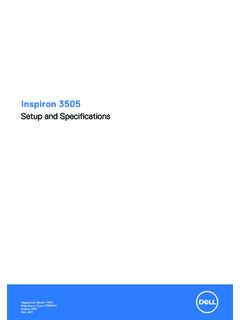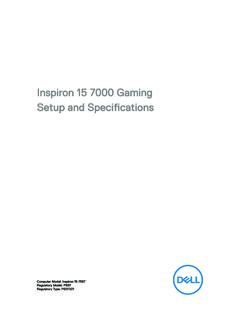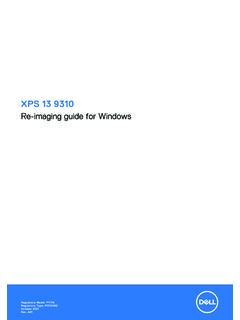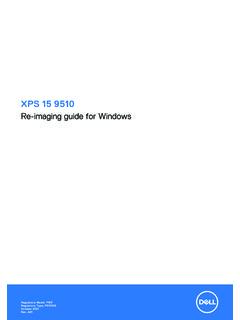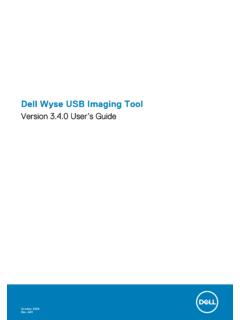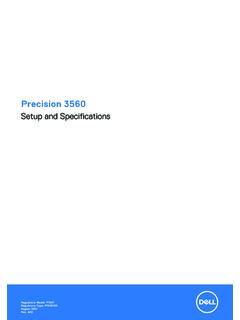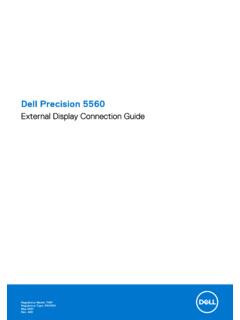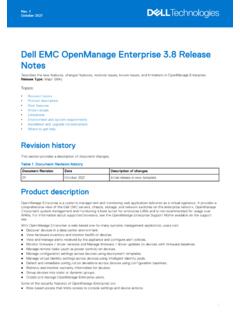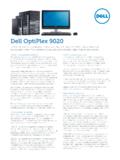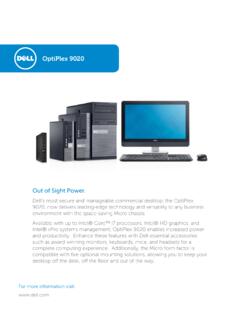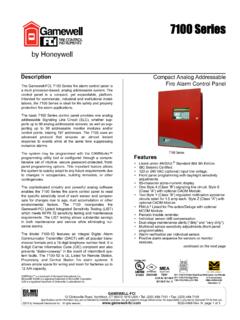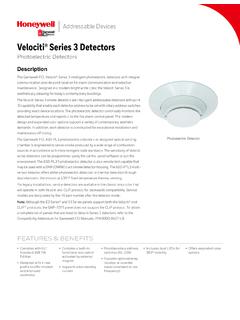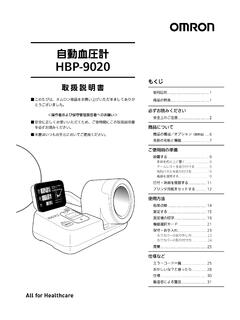Transcription of Dell OptiPlex 9020 Small Form Factor Owner's Manual
1 dell OptiPlex 9020 Small Form Factor Owner's Manual Regulatory Model: D07S. Regulatory Type: D07S001. Notes, cautions, and warnings NOTE: A NOTE indicates important information that helps you make better use of your computer. CAUTION: A CAUTION indicates either potential damage to hardware or loss of data and tells you how to avoid the problem. WARNING: A WARNING indicates a potential for property damage, personal injury, or death. Copyright 2015 dell Inc. All rights reserved. This product is protected by and international copyright and intellectual property laws. dell and the dell logo are trademarks of dell Inc. in the United States and/or other jurisdictions. All other marks and names mentioned herein may be trademarks of their respective companies. 2015 - 03. Rev. A01. Contents 1 Working on Your 5. Before Working Inside Your Turning Off Your 6.
2 After Working Inside Your 2 Removing and Installing 7. Recommended 7. System 7. Inside view .. 7. Removing the Installing the 9. Removing the Front 9. Installing the Front 10. Removing The Expansion 10. Installing The Expansion 12. Removing the Wireless Local Area Network (WLAN) 12. Installing the WLAN 13. Removing the Optical 13. Installing the Optical 14. Removing the Drive 14. Installing the Drive Removing the Hard Installing the Hard 16. Removing the Installing the Memory Module 17. Removing the Installing the Removing the System Installing the System Removing the Power Installing the Power Removing the Input/Output (I/O) 21. Installing the Input/Output (I/O) 22. Removing the Power Installing the Power Removing the Coin-Cell Installing the Coin-Cell 3. Removing the Heat Sink 25. Installing the Heat Sink 26. Removing the Installing the Removing the Intrusion Installing the Intrusion System Board 28.
3 Removing the System Installing the System 3 System 30. Boot 30. Navigation System Setup Updating the BIOS .. 40. Jumper System and Setup Assigning a System Password and Setup 41. Deleting or Changing an Existing System and/or Setup Disabling a System 4 Enhanced Pre-Boot System Assessment (ePSA) 5 Troubleshooting Your Power LED 44. Beep 45. Error 45. 6 49. 7 Contacting 56. 4. 1. Working on Your Computer Before Working Inside Your Computer Use the following safety guidelines to help protect your computer from potential damage and to help to ensure your personal safety. Unless otherwise noted, each procedure included in this document assumes that the following conditions exist: You have read the safety information that shipped with your computer. A component can be replaced or--if purchased separately--installed by performing the removal procedure in reverse order.
4 WARNING: Before working inside your computer, read the safety information that shipped with your computer. For additional safety best practices information, see the Regulatory Compliance Homepage at regulatory_compliance CAUTION: Many repairs may only be done by a certified service technician. You should only perform troubleshooting and simple repairs as authorized in your product documentation, or as directed by the online or telephone service and support team. Damage due to servicing that is not authorized by dell is not covered by your warranty. Read and follow the safety instructions that came with the product. CAUTION: To avoid electrostatic discharge, ground yourself by using a wrist grounding strap or by periodically touching an unpainted metal surface, such as a connector on the back of the computer. CAUTION: Handle components and cards with care.
5 Do not touch the components or contacts on a card. Hold a card by its edges or by its metal mounting bracket. Hold a component such as a processor by its edges, not by its pins. CAUTION: When you disconnect a cable, pull on its connector or on its pull-tab, not on the cable itself. Some cables have connectors with locking tabs; if you are disconnecting this type of cable, press in on the locking tabs before you disconnect the cable. As you pull connectors apart, keep them evenly aligned to avoid bending any connector pins. Also, before you connect a cable, ensure that both connectors are correctly oriented and aligned. NOTE: The color of your computer and certain components may appear differently than shown in this document. To avoid damaging your computer, perform the following steps before you begin working inside the computer. 1. Ensure that your work surface is flat and clean to prevent the computer cover from being scratched.
6 2. Turn off your computer (see Turning Off Your Computer). CAUTION: To disconnect a network cable, first unplug the cable from your computer and then unplug the cable from the network device. 3. Disconnect all network cables from the computer. 4. Disconnect your computer and all attached devices from their electrical outlets. 5. Press and hold the power button while the computer is unplugged to ground the system board. 6. Remove the cover. 5. CAUTION: Before touching anything inside your computer, ground yourself by touching an unpainted metal surface, such as the metal at the back of the computer. While you work, periodically touch an unpainted metal surface to dissipate static electricity, which could harm internal components. Turning Off Your Computer CAUTION: To avoid losing data, save and close all open files and exit all open programs before you turn off your computer.
7 1. Shut down the operating system: In Windows 8: Using a touch-enabled device: a. Swipe in from the right edge of the screen, opening the Charms menu and select Settings. b. Select the and then select Shut down Using a mouse: a. Point to upper-right corner of the screen and click Settings. b. Click the and select Shut down. In Windows 7: 1. Click Start . 2. Click Shut Down. or 1. Click Start . 2. Click the arrow in the lower-right corner of the Start menu as shown below, and then click Shut 2. Ensure that the computer and all attached devices are turned off. If your computer and attached devices did not automatically turn off when you shut down your operating system, press and hold the power button for about 6. seconds to turn them off. After Working Inside Your Computer After you complete any replacement procedure, ensure you connect any external devices, cards, and cables before turning on your computer.
8 1. Replace the cover. CAUTION: To connect a network cable, first plug the cable into the network device and then plug it into the computer. 2. Connect any telephone or network cables to your computer. 3. Connect your computer and all attached devices to their electrical outlets. 4. Turn on your computer. 5. If required, verify that the computer works correctly by running the dell Diagnostics. 6. 2. Removing and Installing Components This section provides detailed information on how to remove or install the components from your computer. Recommended Tools The procedures in this document may require the following tools: Small flat-blade screwdriver Phillips screwdriver Small plastic scribe System Overview The figure below displays the inside view of the Small Form Factor after the base cover has been removed. The call outs show the names and the layout of the components inside the computer.
9 Inside view 1. power supply 2. PCI Express Card 3. intrusion switch 4. processor-fan cover 5. processor fan 7. 6. drive cage 7. optical drive 8. power switch 9. input/output (I/O) Panel 1. memory module 2. speaker 3. front bezel 4. system fan Removing the Cover 1. Follow the procedures in Before Working Inside Your Computer. 2. Pull-up the cover-release latch and lift the cover. Lift the cover upward to a 45 degree angle and remove it from the computer. 8. Installing the Cover 1. Place the cover on the chassis. 2. Press down on the cover till it clicks into place. 3. Follow the procedures in After Working Inside Your Computer. Removing the Front Bezel 1. Follow the procedures in Before Working Inside Your Computer. 2. Remove the cover. 3. Pry the front bezel retention clips away from the chassis. 4. Rotate the bezel away from the computer to release the hooks on the opposite edge of the bezel from the chassis.
10 Then, lift the chassis and remove the front bezel from the computer. 9. Installing the Front Bezel 1. Insert the hooks along the bottom edge of the front bezel into the slots on the chassis front. 2. Push the bezel toward the computer to engage the front bezel retention clips until they click into place. 3. Install the cover. 4. Follow the procedures in After Working Inside Your Computer. Removing The Expansion Card 1. Follow the procedures in Before Working Inside Your Computer. 2. Remove the cover 3. Rotate the release tab on the card-retention latch upward. 10. 4. Pull the release lever away from the expansion card until you release the securing tab from the dent in the card. Then, ease the card up and out of its connector and remove it from the computer. 11. Installing The Expansion Card 1. Insert the expansion card into the connector on the system board and press down to secure it in place.


